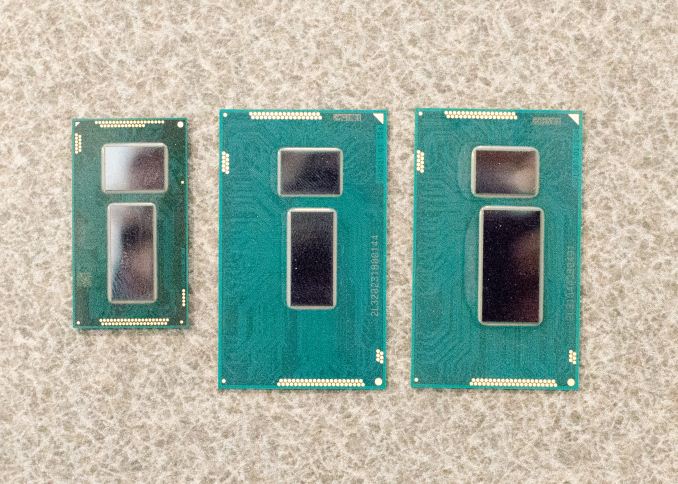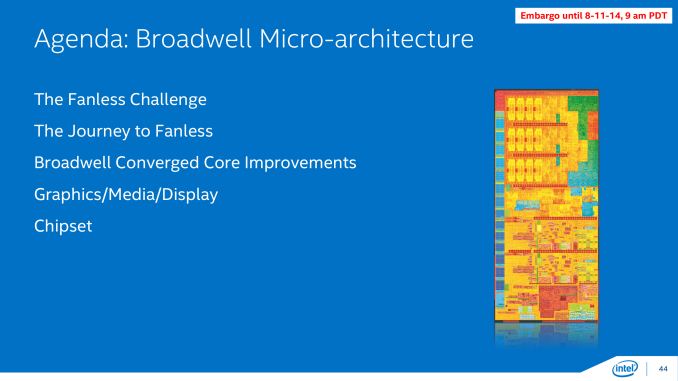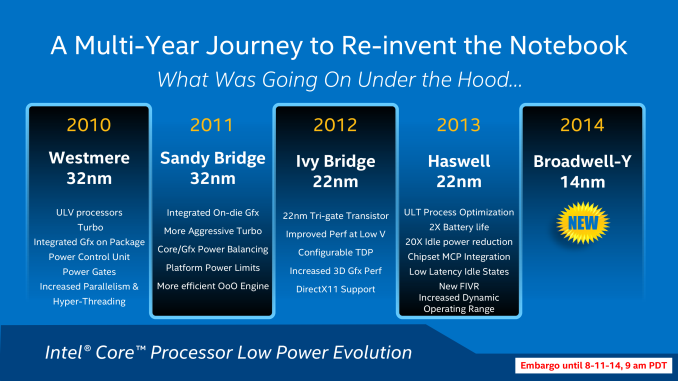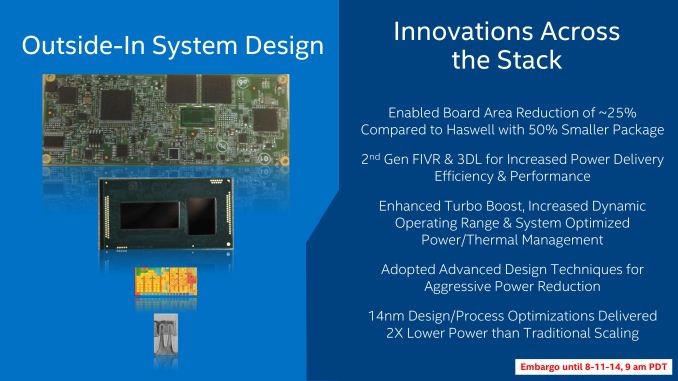Intel Broadwell Architecture Preview: A Glimpse into Core M
by Ryan Smith on August 11, 2014 12:01 PM EST
With Haswell Refresh fully behind us and 2014 now in to its second half, Intel is turning their attention to their next generation of products and processes. Intel’s tick-tock methodology coupled with the long development periods of new products means that the company has several projects in flight at any given time. So while we have seen the name Broadwell on Intel’s roadmaps for some time now, the reality of the situation is that we know relatively little about Intel’s next generation architecture and the 14nm process that it is the launch vehicle for.
Typically we would see Intel unveil the bulk of the technical details of their forthcoming products at their annual Intel Developer Forum, and with the next IDF scheduled for the week of September 9th we’ll see just that. However today Intel will be breaking from their established standards a bit by not waiting until IDF to deliver everything at once. In a presentation coinciding with today’s embargo, dubbed Advancing Moore’s Law in 2014, Intel will be offering a preview of sorts for Broadwell while detailing their 14nm process.
Today’s preview and Intel’s associated presentation are going to be based around the forthcoming Intel Core M microprocessor, using the Broadwell configuration otherwise known at Broadwell-Y. The reason for this is a culmination of several factors, and in all honesty it’s probably driven as much by investor relations as it is consumer/enthusiast relations, as Intel would like to convince consumer and investor alike that they are on the right path to take control of the mobile/tablet market through superior products, superior technology, and superior manufacturing. Hence today’s preview will be focused on the part and the market Intel feels is the most competitive and most at risk for the next cycle: the mobile market that Core M will be competing in.
To that end Intel’s preview is very much a preview; we will see bits and pieces of Broadwell’s CPU architecture, GPU architecture, and packaging, along with information about Intel’s 14nm process. However this isn’t a full architecture preview or a full process breakdown. Both of those will have to wait for Intel’s usual forum of IDF.
Diving into matters then, Core M will be launch vehicle for Broadwell and will be released for the holiday period this year. In fact Intel is already in volume production of the Broadwell-Y CPU and production units are shipping to Intel’s customers (the OEMs) to begin production and stockpiling of finished devices for the holiday launch.
Intel’s decision to initially focus Broadwell on the mobile market comes as the company takes the next step in their plan to extend into the Core processor series into these devices. Arguably, Intel has been slow to response to the rise of ARM devices, whose rapid rise has undercut traditional PC sales and quickly become the biggest threat to Intel’s processor dominance in some number of years. Intel is far from doomed right now, but even they see the potential farther down the line if they do not act.
Intel for their part has responded, but it has taken a step-by-step (multi-year) process that has seen the company progressively build smaller and less power hungry CPUs in order to fit the needs of the mobile market. Since Intel integrated their graphics on-die with Sandy Bridge in 2011, the company has continued to tweak the designs of their products, with Ivy Bridge and Haswell generation products introducing further optimizations and new manufacturing processes. Now on their latest iteration with Broadwell, the company believes they’re turning a corner and have the technology they need to be a leader in the high performance mobile market. It's important to note that despite Intel's best intentions here, Broadwell and Core M remain targeted at premium devices. You won't see these parts in cheap tablets. The duty of doing battle with ARM remains Atom's alone.
Many of these changes ultimately amount to boosting performance and reducing power consumption to a point where power and heat are where they need to be for mobile form factors, either through process efficiency improvements or through better power management and wider dynamic ranges – boosting where it matters and doing a better job of idling between tasks. However as Intel has discovered they not only need to be able to meet the TDP requirements of a tablet but they need to be able to meet the size requirements too. A particularly daunting task when the entire thickness of a device needs to be under 10mm, and the CPU thinner yet.
As a result, coupled with Core M’s performance improvements and power reductions is a strong emphasis on the size of the processor package itself and what Intel could do to reduce it. Intel calls this an outside-in system design, with various parts of Intel focusing on everything from the size of the logic board needed to hold the processor to the thickness of the processor die itself. In the following pages we’ll take a look at Intel’s efforts to get slim, but to kick things off we have a picture of Broadwell-Y from Computex 2014.

From left to right: Broadwell-Y (Core M), Broadwell ULT/ULX and Haswell ULT/ULX
Intel wants a greater foothold in the mobile market and they want it badly. And with Broadwell-Y they believe they finally have what they need to accomplish that goal.














158 Comments
View All Comments
Jaybus - Thursday, August 14, 2014 - link
TDP is "Total Dissipated Power" and as used in describing processors refers to the maximum instantaneous power that the processor will dissipate. Watt, being a unit unit of power, is the only SI unit suitable for specifying TDP. Since nearly all of the energy expended by a processor is due to heat transfer, a Watt is in this case essentially a measure of the rate of heat transfer, and TDP is the rate of heat transfer required when operating the processor at or near its maximum operating temperature.473NG3R - Friday, August 15, 2014 - link
@Jaybus Nope. Please don't correct people with false info. TDP is Thermal Design Power, and it is NOT "peak" power. It is used for marketing as mkozakewich said above as the definition of TDP measurement varies from company to company.473NG3R - Friday, August 15, 2014 - link
Oops! I read mkozakewich comment backwards. It is a marketing term in a sense... It is used to design cooling systems but it gets thrown around by marketing groups all the time since TDP limits how small a device can be.frostyfiredude - Monday, August 11, 2014 - link
With all these reductions in power use on a per core basis and a stagnation of clock speeds we very well could see a quad core i7-5770k with a 65W TDP. I hope Intel plans on bumping up their mainstream high end SKUs to six core, the desktop market doesn't need maximum power use that low.klmccaughey - Monday, August 11, 2014 - link
Yes this worries me too. I think we will see yet another pointless desktop release, with hardly any improvements (once you consider the bad overclocking).I still don't see a desktop Broadwell replacing my 2500k, which runs low(ish) heat at 4.3GHz. What I would love to see is a 5.5GHz Broadwell monster, otherwise I will be skipping broadwell, just like Hazwell and IB before it.
Surely there has to be some light on the horizon for us gamers?!
mapesdhs - Monday, August 11, 2014 - link
And someone in your position also of course has the double irony of still having more
performance headroom if they're willing to explore better cooling, etc. H80i would let
your 2500K run at 5GHz no problem, assuming your particular sample isn't naturally
limited in some way (actually, even an old TRUE and two typical fans would be fine,
something I can confirm as I've done it with several different 2700Ks, never mind a
2500K, so I know the heat isn't an issue). Thus, except for threaded workloads, an
upgrade would have to be a lot better than what you already have in order to be
worth bothering with, except if you wanted something new due to newer tech sych
as PCI Express, M.2, etc.
Anyway, this is why IB was so bad with its default metal cap setup, ie. Intel made SB
too good which resulted in lots of 2500K owners just not seeing the point in upgrading.
Thing is, they've still not boosted performance enough to make upgrading worthwhile
for most SB users (the exception of course being non-K owners).
My 2700K runs at 5.0. Takes me 3 mins to set this up on an ASUS M4E, ludicrously
easy to do. HW at 4.5 is about the same or a bit quicker, but much more complex to
do, given how many samples won't go that high, and for gaming it makes no difference
at all. I suppose the 4790K can help on the oc front a bit, but the cost has put me off so
far, used 2700Ks are so much cheaper. I want to build a 4K gaming system next, but
that'll be X99 instead I think (don't see the point of mainstream chipsets for 4K gaming,
surely with multiple GPUs the limited PCIe lanes is going to hold back performance
eventually).
Ian.
garadante - Tuesday, August 12, 2014 - link
I wish I had your luck with SB. My 2500k will only do 4.5 GHz stable with 1.365 vcore (in reality, monitoring software reports 1.391~ vcore with my motherboard's way of handling vdroop). If I could go any higher, I'd have to dump a load of voltage into it that I'm just afraid of doing. Though this may be a motherboard problem as it's given me problems before, but that still wouldn't account for a 500 MHz variance. I guess I just got a bad SB. :/pt2501 - Monday, August 11, 2014 - link
You said it. My 2500k at 4.6 Ghz isn't going anywhere unless something revolutionary is released. Best processor I ever bought.ZeDestructor - Monday, August 11, 2014 - link
They want you to go up to LGA2011 for the solder-based TIM. And only because of die-cracking issues (I found the papers covering that) on smaller dies that force them to use boring old polymer TIM.steve wilson - Tuesday, August 12, 2014 - link
My thoughts exactly. My 2500k runs everything fine for me at 4.4ghz. I will be skipping Broadwell and praying Skylake will deliver.